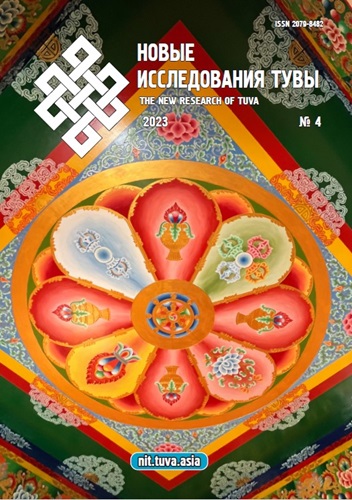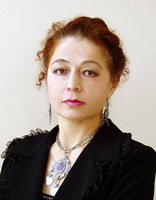Tuprak ‘land, soil’ in the myphoritual traditions of the Bashkirs: origins, features and modern modifications
DOI:
https://doi.org/10.25178/nit.2023.4.22Keywords:
land worship; Mother Earth; tuprak; Bashkirs; Bashkir language; ritual; myth; Bashkir culture; Bashkir folkloreAbstract
The article delves into the mythological origins, transformations, and contemporary realities of worship practices and traditions related to the sanctification of land and soil, as conveyed through the concepts in Bashkir linguoculture, namely “tupraq” and “yer”.
The traditional Bashkir system of venerating the land can be traced back to myths depicting its living essence, the inherent blood relationship between the land and humanity, and the recognition of the land's sacredness, emanating from the essence of the demigod Ural-Batyr. Subsequent modifications of these concepts occurred in alignment with the evolving objectives of calendar rites, practices, and rituals, adapting practically for agricultural pursuits and healing rituals. Rituals dedicated to the land exhibit a synthesis and amalgamation of Tengrian and Islamic beliefs.
However, contemporary policies regarding land sales and the disregard for the respectful treatment of the land have generated a discord with traditional values. This disjunction has led to a sense of concern evident in public discourse and contemporary folklore.
References
Akmanov, I. G. (1998) Bashkirskie vosstaniia XVII — nachala XVIII vv. [Bashkir uprisings of the XVII — early XVIII centuries]. Ufa, Kitap. 224 p. (In Russ.).
Alekseev, N. A. (1984) Shamanizm tiurkskikh narodov Sibiri [Shamanism of the Turkic peoples of Siberia]. Novosibirsk, Nauka. 233 p. (In Russ.).
Bideeva, S. Ch. (2014) Prirodookhrannye traditsii osetin [Environmental traditions of Ossetians]. Istoricheskie, filosofskie, politicheskie i iuridicheskie nauki, kul'turologiia i iskusstvovedenie. Voprosy teorii i praktiki, no. 5–1 (43), pp. 32–34. (In Russ.).
Gumilev, L. N. (1993) Drevnie tiurki [Ancient Turks]. Moscow, Klyshnikov, Komarov i Ko. 536 p. (In Russ.).
Dugarov, D. S. (1981) K etimologii slova «Iuuren, uur, uury» [To the etymology of the word “Yuuren, uur, uur”]. Sovetskaia etnografiia, no. 1, pp. 98–102. (In Russ.).
Ilimbetova, A. F. (2020) Simvolika kamnia v fol'klore, obriadakh i obychaiakh Bashkir [The symbolism of the stone in folklore, rituals and customs of Bashkirs]. Ufa, Mir pechati. 168 p. (In Russ.).
Istoriia bashkirskikh rodov. Gaina [The history of Bashkir families. Gaina] (2015): in 47 vol. / comp. by S. I. Khamidullin et al. Ufa, GUP RB Ufimskii poligrafkombinat. Vol. 11. 696 p. (In Russ.).
Isiangulov, Sh. N. (2008) Maloizuchennye aspekty istorii dorevoliutsionnogo Bashkortostana [Little-studied aspects of the history of pre-revolutionary Bashkortostan]. Ufa, Aerokosmos i noosfera.134 p. (In Russ.).
Kazagacheva, Z. S. (2002) Altaiskie geroicheskie skazaniia Ochi-balai Kan-Altyn. Aspekty tekstologii i perevoda [Altai heroic tales of Ochi-bala Kan-Altyn. Aspects of textology and translation]. Gorno-Altaisk, Gorno-Alt. tip. 347 p. (In Russ.).
Kovalevskii, A. P. (1956) Kniga Akhmeda ibn-Fadlana o ego puteshestvii na Volgu v 921–922 gg. [The book of Ahmed ibn-Fadlan about his journey to the Volga in 921–922]. Khar'kov, Izd-vo Khar'kovskogo gos. universiteta im. A. M. Gor'kogo. 345 p. (In Russ.).
Kondybai, S. (2005) Baiyrғy kazak dünietanymynyng negizderi. Entsiklopediialyk basylym [Fundamentals of the worldview of the indigenous Cossacks. Encyclopedic edition]. Almaty, Kazak tili baspasy. 480 bet. (In Kaz.).
Kychanov, E. I. and Mel'nichenko, B. N. (2005) Istoriia Tibeta s drevneishikh vremen do nashikh dnei [The history of Tibet from ancient times to the present day]. Moscow, Vostochnaia literatura. 351 p. (In Russ.).
Lamazhaa, Ch. K. (2021) Ocherki sovremennoi tuvinskoi kul'tury [Essays on modern Tuvan culture]. St. Petersburg, Nestor-Istoriia. 192 p. (In Russ.).
Mainy, Sh. B. (2023) Predstavleniia o cher ‘zemle’ sovremennykh tuvintsev [Perceptions of ‘cher’ (‘earth’) among contemporary Tuvans]. New Research of Tuva, no. 1, pp. 38–63. (In Russ.). DOI: https://doi.org/10.25178/nit.2023.1.3
Mukhambetova, A. I. (2001) Tengrianskii kalendar' i vremia v kazakhskoi kul'ture [Tengrian calendar and time in Kazakh culture]. Evraziia, no. 2, pp. 12–22. (In Russ.).
Suvandii, N. D. (2023) Cher ‘zemlia’ v paremiiakh tuvintsev [Cher ‘earth’ in Tuvan paroemias]. New Research of Tuva, no. 1, pp. 26–37. (In Russ.). DOI: https://doi.org/10.25178/nit.2023.1.2
Sagalaev, A. M. (1991) Uralo-altaiskaia mifologiia: simvol i arkhetip [Ural-Altai mythology: symbol and archetype]. Novosibirsk, Nauka, Sibirskoe otdelenie. 156 s. (In Russ.).
Salikhov, G. G. and Galimov, B. S. (2018) Mify v kartine mira Bashkir [Myths in the picture of the Bashkir world]. Ufa, Kitap. 208 p. (In Russ.).
Salmin, A. K. (2007) Sistema religii chuvashei [The Chuvash religion system]. St. Petersburg, Nauka. 654 p. (In Russ.).
Sultangareeva, R. A. (1998) Semeino-bytovoi obriadovyi fol'klor bashkirskogo Naroda [Family and household ritual folklore of the Bashkir people]. Ufa, Gilem. 243 p. (In Russ.).
Sultangareeva, R. A. (2019) Bashkirskii fol'klor: semantika, funktsii i traditsii [Bashkir folklore: semantics, functions and traditions]: in 2 vol. Ufa, Bashkirskaia entsiklopediia. Vol. 2. Kalendarnyi fol'klor: mif i ritual [Calendar folklore: Myth and Ritual]. 296 p. (In Russ.).
Traditsionnoe mirovozzrenie tiurkov Iuzhnoi Sibiri. Prostranstvo i vremia. Veshchnyi mir [The traditional worldview of Turkic peoples of South Siberia. Space and time. The outer world] (1988) / ed. by L'vova E. L., Oktiabr'skaia I. V., Sagalaev A. M. and Usmanova M. S. Novosibirsk, Nauka. 226 p.(In Russ.).
Cheremshanskii, V. M. (1859) Opisanie Orenburgskoi gubernii v khoziaistvenno-statisticheskom, etnograficheskom otnosheniiakh [Description of the Orenburg province in economic, statistical, ethnographic relations]. Ufa, Tip. Orenburgskogo gubernskogo pravleniia. 452 s. (In Russ.).
Shuklin, V. V. (1995) Mify russkogo Naroda [Myths of the Russian people]. Ekaterinburg: Bank kul'turnoi informatsii. 336 p. (In Russ.).
Published
How to Cite
For citation:
Sultangareeva R. A. Tuprak ‘zemlia, pochva’ v miforitual’nykh traditsiiakh bashkir: arkhaichnye istoki, osobennosti i sovremennye modifikatsii [Tuprak ‘land, soil’ in the myphoritual traditions of the Bashkirs: origins, features and modern modifications]. New Research of Tuva, 2023, no. 4, pp. 314-327. DOI: https://doi.org/10.25178/nit.2023.4.22
Issue
Section

This work is licensed under a Creative Commons Attribution-NonCommercial 4.0 International License.

Author(s) license holder(s) grant rights for their work to the journal (grantee of a license) under the simple non-exclusive open license in accordance with Art. 1286.1 «Open license for a research work, work of literature or fine arts», Civil Code of the Russian Federation.
New Research of Tuva publishes articles under the Creative Commons Attribution-NonCommercial license (CC BY-NC).
Since it is an open license, author(s) reserve the right to upload the article to their institutional repository, submit it to another journal (if it allows republications), or republish it on their own website (in full, or in part).
However, several conditions apply here:
a) The republished version must always contain the name(s) and affiliation(s) of the author(s), the original title and the hyperlink to the original version on the New Research of Tuva website;
b) It must be in open access, free of charge, and no category of readers must be in any way whatsoever advantaged over general readership.
c) should the contribution be submitted elsewhere by its author(s) without substantial modification (30% or more of original text unchanged), the body of the article should contain a disclaimer that the original version was published in New Research of Tuva (with a link to the respective page)
The CC-BY-NC is a non-revocable license which applies worldwide and lasts for the duration of the work’s copyright.









